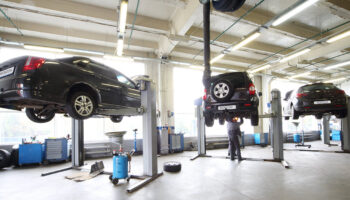Driving during a storm can be one of the most unpredictable experiences a motorist faces. From flash floods to heavy winds and icy conditions, storms push both drivers and vehicles to their limits. When cars break down in such extreme weather, it becomes more than an inconvenience—it’s a safety concern. This is why having access to a trusted auto repair shop that can handle emergency breakdowns during storms is essential. These professionals are trained to manage storm-related car issues quickly and effectively, ensuring drivers are back on the road safely and without unnecessary stress.
The Challenges of Vehicle Breakdowns During Storms
Storms create harsh conditions that affect both the driver’s visibility and the mechanical performance of vehicles. Heavy rain or snow can damage electrical systems, reduce traction, and flood engine components. Strong winds can also cause accidents or push debris into moving parts. When a breakdown occurs under these conditions, traditional roadside solutions might not be enough. Auto repair shops that specialize in emergency storm responses understand the complexity of these situations and follow specific procedures to ensure vehicles are repaired safely and efficiently.
Common Storm-Related Car Problems
Storm damage can affect various systems in a car. The following are some of the most frequent issues that lead to emergency repairs:
- Battery Failure: Cold and wet conditions reduce a battery’s efficiency, especially if it’s near the end of its lifespan.
- Electrical System Malfunctions: Water exposure can short-circuit sensors, alternators, and fuses.
- Engine Stalling or Flooding: Floodwater entering the air intake or exhaust system can shut down the engine.
- Brake System Issues: Excessive water or debris can affect brake pad grip and hydraulic performance.
- Tire Damage: Nails, glass, or sharp debris often scatter across roads during storms, leading to punctures or blowouts.
- Suspension Wear: Driving through deep water or potholes can harm shocks and struts, making the vehicle unstable.
Each of these problems requires a specific inspection and repair process, which is why professional help from an auto repair shop is crucial.
How Auto Repair Shops Respond to Storm-Related Emergencies
When a breakdown occurs during a storm, response time and safety procedures become top priorities. Auto repair shops with emergency services have detailed protocols for handling such situations efficiently.
1. Rapid Emergency Dispatch and Communication
Many repair shops maintain 24/7 emergency contact lines to assist stranded motorists. Once a call is received, technicians gather critical details such as the driver’s location, vehicle make and model, and symptoms of the issue. They then coordinate with towing services to retrieve the car safely.
Advanced auto repair shops often use GPS-based systems to dispatch the nearest service team or tow truck. This reduces wait times and ensures that help arrives as quickly as possible, even during poor weather conditions.
2. Safety Protocols During Storm Recovery
Safety is the first concern when dealing with a stranded vehicle. Technicians follow strict safety procedures to protect both the driver and the recovery team.
Common safety steps include:
- Setting up warning flares or reflective cones around the vehicle
- Wearing high-visibility gear
- Avoiding flooded or unstable areas
- Disconnecting the battery before inspection to prevent electrical shock
- Using insulated tools to work around wet components
Auto repair professionals are trained to assess storm-related hazards before starting any repair work.
3. Towing and Transportation Procedures
When a car can’t be repaired roadside, towing becomes necessary. During storms, towing requires extra caution because wet or icy roads increase the risk of skidding.
Professional towing procedures include:
- Using heavy-duty winches and waterproof cables
- Securing vehicles with non-slip chains
- Transporting the vehicle to a safe, covered repair bay
Once the car arrives at the shop, technicians perform a detailed inspection to identify damage caused by water, debris, or impact.
4. Initial Diagnostic Evaluation
After receiving a storm-damaged vehicle, the repair process begins with a comprehensive diagnostic check. Auto repair shops use electronic diagnostic tools to scan the vehicle’s control modules for faults.
Technicians typically check:
- Electrical circuits and fuses for water intrusion
- Battery voltage and alternator output
- Engine and transmission control systems for error codes
- Brake line pressure and fluid quality
- Tire condition and alignment
This step helps determine the scope of damage and prioritize repairs that restore the vehicle’s safety and drivability.
Addressing Specific Storm-Induced Damages
Electrical and Battery Repairs
Electrical failures are among the most common storm-related breakdowns. Moisture and humidity can infiltrate fuse boxes, alternators, and connectors.
Repair shops handle these issues by:
- Drying and cleaning all affected electrical components
- Using dielectric grease on connectors to prevent corrosion
- Testing alternator output and replacing damaged wiring
- Installing new batteries when voltage falls below acceptable levels
Technicians also inspect the starter motor, ignition coil, and onboard computer systems to ensure they function correctly after exposure to moisture.
Engine and Fuel System Restoration
If a vehicle is exposed to floodwater, the engine is at risk of hydro-locking—a condition where water enters the cylinders and prevents piston movement. This can cause severe internal damage.
Professional inspection involves:
- Draining contaminated oil and fuel
- Checking air filters for moisture or mud
- Cleaning the intake and exhaust systems
- Flushing fuel lines and replacing filters
In severe cases, auto repair shops may disassemble the engine for internal cleaning and replacement of damaged components like spark plugs and sensors.
Brake System Maintenance After Storms
Wet conditions and flooding can reduce braking performance. Water entering the brake system can cause rust and affect hydraulic pressure.
Technicians address this by:
- Inspecting rotors, calipers, and brake pads for corrosion
- Replacing brake fluid if contamination is detected
- Testing ABS sensors for electrical issues
- Cleaning and re-lubricating components for optimal performance
Reliable brakes are crucial during storm conditions, so repair shops prioritize these inspections before returning the car to the road.
Tire and Suspension Repairs
Storms often cause road debris and hidden potholes, leading to tire and suspension damage.
Auto repair shops perform:
- Tire inspections for punctures, bulges, and tread depth
- Pressure adjustments to factory specifications
- Wheel alignment and balancing to correct misalignment caused by impact
- Suspension checks on shocks, struts, and control arms for wear
Proper alignment and suspension repair ensure stable handling and prevent uneven tire wear after the storm.
Interior and Cabin Restoration
When floodwater reaches the cabin, it can ruin upholstery, carpeting, and electronic systems inside the dashboard.
Repair shops restore interiors by:
- Removing seats, carpets, and insulation to dry completely
- Using industrial dehumidifiers to eliminate trapped moisture
- Cleaning surfaces with antimicrobial agents to prevent mold growth
- Replacing the cabin air filter and inspecting HVAC systems
- Testing dashboard components, including airbags and sensors, for corrosion or short circuits
This meticulous approach ensures that the vehicle remains safe and comfortable after storm damage.
Preventive Maintenance for Future Storms
Auto repair shops not only fix immediate issues but also help car owners prepare for future storm conditions. Preventive maintenance is key to reducing the risk of breakdowns.
Key Preventive Recommendations:
- Regular Battery Checks: Ensure terminals are clean and connections are tight before storm season.
- Inspect Seals and Weather Stripping: Replace worn seals around doors and windows to prevent water leaks.
- Keep Tires in Good Condition: Adequate tread depth provides better traction in wet conditions.
- Maintain Fluid Levels: Proper coolant, brake, and transmission fluid levels protect internal systems from moisture-related damage.
- Avoid Low-Lying Parking Areas: Whenever possible, park on higher ground to prevent flooding exposure.
By following these steps, drivers can reduce their chances of experiencing storm-related breakdowns.
How Auto Repair Shops Train for Emergency Scenarios
Handling breakdowns during storms requires more than technical skills—it demands experience and preparation. Many auto repair shops conduct regular emergency response training for their staff.
Training focuses on:
- Safe towing and vehicle recovery techniques
- Electrical hazard management
- Customer communication during emergencies
- Rapid diagnostic testing and moisture control
- Coordination with insurance providers for storm claims
This structured approach ensures that every technician is equipped to handle challenging storm situations professionally and safely.
The Importance of Partnering with a Trusted Auto Repair Shop
Not every mechanic or roadside service has the expertise to deal with storm-related breakdowns. Partnering with a reputable auto repair shop gives drivers access to trained professionals, advanced diagnostic tools, and weather-resistant repair procedures. These shops also offer transparent assessments, ensuring you know exactly what repairs are necessary and which components are salvageable.
FAQs
Q1: What should I do immediately if my car breaks down during a storm?
Pull over safely, turn on hazard lights, and avoid leaving the vehicle if conditions are dangerous. Call your auto repair shop or roadside assistance for help.
Q2: Can I start my car after it’s been exposed to deep water?
No. Starting a flooded car can cause severe engine damage. Have it towed to a repair shop for professional evaluation first.
Q3: How do I know if my brakes were affected by a storm?
If you feel a delay in braking response, hear squeaking, or experience vibrations, your brakes may have moisture or rust. Have them checked immediately.
Q4: Is insurance likely to cover storm-related breakdowns?
Most comprehensive auto insurance policies cover flood and storm damage. Your repair shop can help document repairs for your claim.
Q5: How long does it take to repair a storm-damaged car?
Repair time varies depending on the severity of the damage. Minor electrical repairs may take a few hours, while flood restoration could take several days.
Q6: Are electric and hybrid vehicles more vulnerable to storm damage?
Yes, since they rely on extensive electrical systems. However, certified auto repair shops have specific tools to handle high-voltage components safely.
Q7: Can moisture inside a car cause long-term problems?
Absolutely. Moisture can corrode electronics, cause mold, and damage upholstery if not addressed quickly and professionally.
Relying on a skilled auto repair shop during storm-related emergencies can make the difference between a safe recovery and a costly disaster. With professional diagnostics, advanced tools, and weather-specific expertise, these shops ensure your vehicle is restored efficiently, keeping you safe no matter what nature throws your way.





